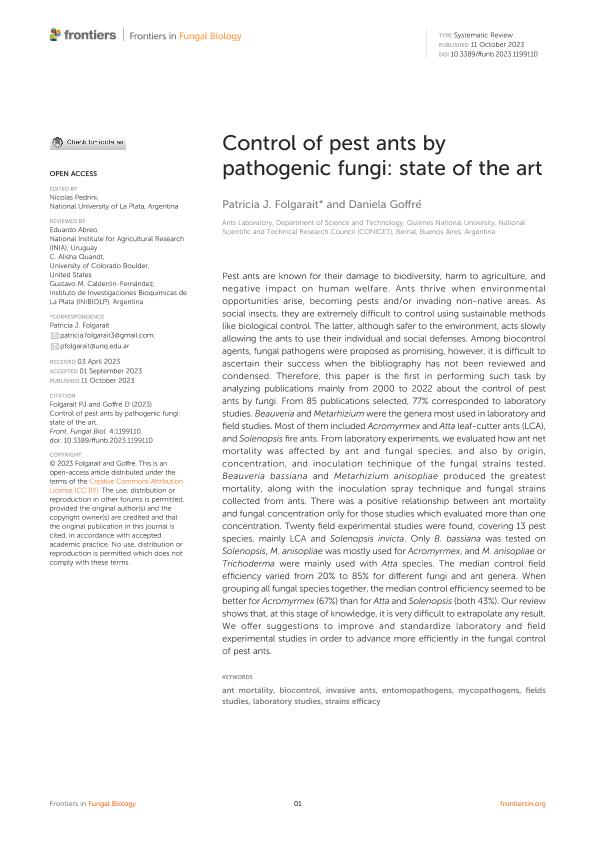Mostrar el registro sencillo del ítem
dc.contributor.author
Folgarait, Patricia Julia

dc.contributor.author
Goffré, Daniela

dc.date.available
2023-12-07T11:02:46Z
dc.date.issued
2023-10
dc.identifier.citation
Folgarait, Patricia Julia; Goffré, Daniela; Control of pest ants by pathogenic fungi: State of the art; Frontiers Media; Frontiers in Fungal Biology; 4; 1199110; 10-2023; 1-20
dc.identifier.uri
http://hdl.handle.net/11336/219607
dc.description.abstract
Pest ants are known for their damage to biodiversity, harm to agriculture, and negative impact on human welfare. Ants thrive when environmental opportunities arise, becoming pests and/or invading non-native areas. As social insects, they are extremely difficult to control using sustainable methods like biological control. The latter, although safer to the environment, acts slowly allowing the ants to use their individual and social defenses. Among biocontrol agents, fungal pathogens were proposed as promising, however, it is difficult to ascertain their success when the bibliography has not been reviewed and condensed. Therefore, this paper is the first in performing such task by analyzing publications mainly from 2000 to 2022 about the control of pest ants by fungi. From 85 publications selected, 77% corresponded to laboratory studies. Beauveria and Metarhizium were the genera most used in laboratory and field studies. Most of them included Acromyrmex and Atta leaf-cutter ants (LCA), and Solenopsis fire ants. From laboratory experiments, we evaluated how ant net mortality was affected by ant and fungal species, and also by origin, concentration, and inoculation technique of the fungal strains tested. Beauveria bassiana and Metarhizium anisopliae produced the greatest mortality, along with the inoculation spray technique and fungal strains collected from ants. There was a positive relationship between ant mortality and fungal concentration only for those studies which evaluated more than one concentration. Twenty field experimental studies were found, covering 13 pest species, mainly LCA and Solenopsis invicta. Only B. bassiana was tested on Solenopsis, M. anisopliae was mostly used for Acromyrmex, and M. anisopliae or Trichoderma were mainly used with Atta species. The median control field efficiency varied from 20% to 85% for different fungi and ant genera. When grouping all fungal species together, the median control efficiency seemed to be better for Acromyrmex (67%) than for Atta and Solenopsis (both 43%). Our review shows that, at this stage of knowledge, it is very difficult to extrapolate any result. We offer suggestions to improve and standardize laboratory and field experimental studies in order to advance more efficiently in the fungal control of pest ants.
dc.format
application/pdf
dc.language.iso
eng
dc.publisher
Frontiers Media

dc.rights
info:eu-repo/semantics/openAccess
dc.rights.uri
https://creativecommons.org/licenses/by/2.5/ar/
dc.subject
ANT MORTALITY
dc.subject
BIOCONTROL
dc.subject
INVASIVE ANTS
dc.subject
ENTOMOPATHOGENS
dc.subject
MYCOPATHOGENS
dc.subject
FIELD STUDIES
dc.subject
LABORATORY STUDIES
dc.subject
STRAINS EFFICACY
dc.subject.classification
Otros Tópicos Biológicos

dc.subject.classification
Ciencias Biológicas

dc.subject.classification
CIENCIAS NATURALES Y EXACTAS

dc.title
Control of pest ants by pathogenic fungi: State of the art
dc.type
info:eu-repo/semantics/article
dc.type
info:ar-repo/semantics/artículo
dc.type
info:eu-repo/semantics/publishedVersion
dc.date.updated
2023-12-06T14:57:46Z
dc.identifier.eissn
2673-6128
dc.journal.volume
4
dc.journal.number
1199110
dc.journal.pagination
1-20
dc.journal.pais
Suiza

dc.journal.ciudad
Lausana
dc.description.fil
Fil: Folgarait, Patricia Julia. Consejo Nacional de Investigaciones Científicas y Técnicas; Argentina. Universidad Nacional de Quilmes. Departamento de Ciencia y Tecnología. Laboratorio de Hormigas; Argentina
dc.description.fil
Fil: Goffré, Daniela. Consejo Nacional de Investigaciones Científicas y Técnicas; Argentina. Universidad Nacional de Quilmes. Departamento de Ciencia y Tecnología. Laboratorio de Hormigas; Argentina
dc.journal.title
Frontiers in Fungal Biology
dc.relation.alternativeid
info:eu-repo/semantics/altIdentifier/url/https://www.frontiersin.org/articles/10.3389/ffunb.2023.1199110/full
dc.relation.alternativeid
info:eu-repo/semantics/altIdentifier/doi/http://dx.doi.org/10.3389/ffunb.2023.1199110
Archivos asociados
